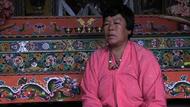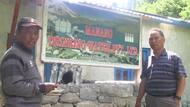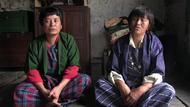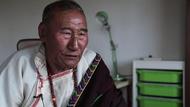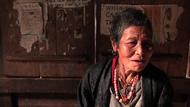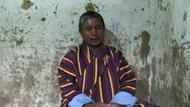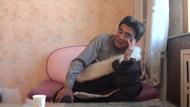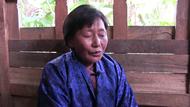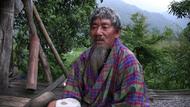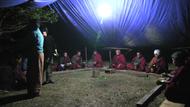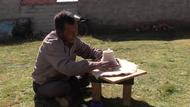Video Overview
Yarlung resident, Tenzin, recalls his personal history as a monk, herder, and servant in a the Nedong region.
- Lhokha
- Nedong Nga Khül
- དྲི་བ་ལེན་མཁན་ Questionerཨཱ་ནི་པཱ་ལགས་འོ་ད་གིན་མགོ་ནས་མཚན་ལ་ག་རེ་ཞུ་གི་ཡོད།Sir, please tell us again. What is your name?
- བསྟན་འཛིན་ Tenzinམིང་ལ་བསྟན་འཛིན་ཟེར་གྱི་ཡོད།My name is Tenzin.
- འོ་འདི་ཡིན་ཙང་ཆུང་ཆུང་ནས་ཡིན་དུས་བཀྲ་ཤིས་ལྷུན་པོ་གྲྭ་པ་བྱས། དེ་ནས་དགོན་པའི་ནང་ནས་ཆོས་ཐོག་བྱས། དེ་ནས་ཚུར་ཆོས་ཐོག་ལ་ཡོང་བ་ཡིན། ལོ་བཅུ་བཞི་སྐབས་ལ་ང་ལུང་པ་འདིའི་ནང་སླེབས་པ་རེད།When I was a child, I became the monk at Trashi Lhünpo. Later I left the monastery and arrived in this place when I was fourteen years old.
- ལྟ་ཕོ་བྲང་རང་ལ་ང་གཡོག་རྒྱུགས་བསྡད་དུས་ལོ་བཅོ་དགུའི་ལོ་འདའི་གཡོག་རྒྱུགས་བསྡད་བ། ལོ་དེ་དུས་ངའི་གཡོག་རྒྱུགས་སའི་མི་ཚང་འདིའི་ནང་ལ་བསྡད་དུས་དེ་ནས་རྨོའོ་རྒན་ཁོག་དགུང་མོ་ཉལ་བསྡད་དུས་ལྟ་དར་ལྕོག་གཞིགས་རྒྱོག་ཡ་གི་དང་ཐོག་རྫོང་འདི་འོ་འདི་ཡིན་ན། ཕོ་བྲང་རྫོང་ཟེར་ཡག་འདི།I began to serve the palace when I was nineteen. In that house, there was an old lady. At night before sleep, I used to ask her about the history of the palace, the Podrang Dzong.
- གནའ་ལ་བྱས་ན་འོ་རྒྱལ་མོ་གཅིག་ཡོད་བ་ཟེར་གྱིས། དེའི་དབུ་གཞིས་དེ་གཏན་གཏང་ཞུ་ཡག་མི་འདུག ལྟ་དངོས་སུ་རང་བྱས་ན་ཆོས་རྒྱལ་མེས་ཨོག་ཚོམ་ཟེར་མཁན་དེ་རྒྱལ་པོ་ཁྲི་སྲོང་ལྡེའུ་བཙན་གྱི་པ་ཕ་དེ། ཆོས་རྒྱལ་མེས་ཨོག་ཚོམ་ཟེར་ཡག་དེའི་ཕོ་བྲང་རེད་ཟེར།Although she didn't know the details, she said that a queen lived in the old palace in ancient time. Originally, the palace was for the dharma king Mé Ok Tsom, the father of King Trisong Deutsen.
- ཆོས་རྒྱལ་ཕོ་བྲང་ཟེར་འོ་འདུག་སེ་བྱས་ཡིན་བ་ཟེར། ཆོས་རྒྱལ་མེས་ཨོག་ཚོམ་གྱི་ཕོ་བྲང་རེད་ཟེར། འོ་འདུག་སེ་བྱས་ཟེར་གྱིས། ལྟ་དེ་ཡིན་ཙང་སོག་པོ་ཇུང་གར་གྱི་དམག་སྐབས་ལ་དེ་ནས་ཁང་པ་དེ་བསྟན་དགྲའི་འོག་ཏུ་ཕྱིན་བྱས། དམག་བརྒྱབ་ནས་དེ་ཁང་པ་འོ་དེ་ཡོད་པའི་ཅ་ལག་གང་ག་བསྡད་བ་ཟེར། འོ་འདུག་སེ་བྱས་བ་ཟེར།That's how the palace got its name as Chögyel Podrang [King's Palace] because the dharma king Mé Ok Tsom once lived there. When Dzungar Mongols invaded Tibet, they destroyed the original palace. However, the lower parts of the structure survived the destruction.
- ལྟ་དབུ་གཞིས་དེས་ང་ལ་བཤད་པ་རེད་འདུག་སེ་བྱས། དེ་ནས་ངས་ས་འོག་ལ་་་ཆེ་ལེན་ཁ་འཐད་མྱོང་ངས་བྱས་ནས། འགྲོ་མྱོང་ཟེར་བ་དེ་མར་། རྐང་ཕྲང་དེ་མར་རྡོ་བཀྱག་ཡོད་བ། དེ་ནས་རྡོ་བཀྱག་མར་འདི་ནས་ཡར་བུ་མོ་གཞོན་གཞོན་ཡིན་ཙང་ཕྱུ་པའི་འདི་པ་ཨེར་ཁ་སྒྲོགས།This is what the old lady told me. Then I asked her whether she had gone below the palace to fetch water from the underground. She said that she used to go down there by climbing down the stone stairs.
- ཨེར་ཁ་ཤིག་ཤིག་ཤིག་སེ་མར་ཕྱིན། དེ་ནས་ཛམ་ཛམ་གང་འདུག་པ་བྱས། མཚམས་མཚམས་ཡར་ཆུ་འཁྱེར་ཡོང་དུས། དེ་ནས་ཞུ་མར་་་་སྤར་བཞག་འོ་འདུག་སེ་བྱས་བཤད་མྱོང་པ། དབུ་གཞིས་དེས་ང་ལ་བཤད་པ་དེ་མི། ཚིམས་འདུ་ཁང་ཟེར་ནང་བ། དབུ་གཞིས་དེ་ལོ་རྒན་འཁོགས་རྒན་འཁོགས་བ། དེ་ནས་མི་ཞ་ཀོག་[ཞ་ར་]ཆགས།As a young lady at the time, she would wear sleigh bells, producing a sik-sik sound as she went down the stone stairs. When asked what she found down there, she said that there were marks left by lamps once used at the site. She was an elderly lady from the house of Tsim Dukhang. Later she became blind.
- འོ་འདི་ཡིན་ཙང་གཙང་ནས་ཡོང་ཡག་དེ་འོ་འདུག་སེ་བྱས། ནང་ནས་བྱས་ན་གྲྭ་པ་བྱས། ལོ་བརྒྱད་ལོ་འདའི་གྲྭ་པ་བྱས་དགོན་པའི་ནང་ལ། བཀྲ་ཤིས་ལྷུན་པོ་དགའ་ལྡན་རབ་རྒྱས་བ་དགོན་པ་དེ། ཡ་གིར་དཔོན་པོ་དེ་དགའ་ལྡན་རབ་རྒྱས་ཟེར་གྱི་བ། ཐུབ་བསྟན་དགའ་ལྡན་རབ་རྒྱས་ཟེར།That's how I came from Tsang. At eight, I became a monk at Trashi Lhünpo Monastery. Its leader was Ganden Rabgyé. His full name is Tupten Ganden Rabgyé.
- དེ་ནས་ལོ་བཅུ་བཞི་ལོ་འདའི་དེ་ནས་ཞོགས་ཀས་འཚོག་ལ་འགྲོ་དུས་ཞོགས་ཀས་མིས་འགྱེད་སྐྱེལ་མཁན་བྱུང་པས་ན། ཞོགས་ཀས་འགྱེད་དེ། དེའི་ཞོགས་ཀས་འདའི་མི་རེ་ལ་ཊམ་ཀ་བཅུ་ཐམ་པ་ཐམ་པ་ཡོད་པ་ཟེར།When I was fourteen, one morning while I was heading to attend the regular morning prayer, I found that a patron was going to offer money to monks. And each monk would get ten tamkas [coins].
- དེ་འགྱེད་རྒྱག་དུས་ཙམ་པ་གཅིག་དང་གཉིས་ཐུབ་མེད་བ། གང་ཡིན་ཟེར་ན། བརྒྱ་ཐམ་པ་ཐམ་པ་ཐུང་ང་དེ། དེ་ནས་གྲངས་ཀ་གཅིག་གཉིས་གསུམ་བཞི་བརྒྱ་ཐམ་པ་མི་སུ་ལ་འཁེལ་ན་དེ་ནས་འདི་ཟིན་བྱས་མ་ཕྱིན་ན་དེ་ནས་ཞོགས་ཀས་འགྱེད་རླག་པ། དེའི་ཞོགས་ཀས་འདི་ཡ་གིར་བརྒྱ་ཐམ་པ་རྒྱག་དུས་་་ཁམས་པ་གཅིག་ལ་འཁེལ།As it would take a long time to hand the coins to each monk, instead, they gave the money in a small bag with one hundred tamkas in it to the tenth person in a file when they count the head from one to ten. You had to follow that tenth person. Otherwise, you would lose your money. That day, the man who received the bag of money for my group was a Khampa monk.
- དེ་ན་ཁམས་པ་དེ་བརླགགས་ཕྱིན། དེ་ནས་ཡ་གིར་ཆོས་ཐོག་ལ་ཡོང་དགོས་ཡག་དེ་འོ་འདི། ཞོགས་ཀས་དེ་འགྱེད་དེ་བརླགས། དེ་ནས་དགེ་རྒན་ནང་ལ་སླེབས་པ་དང་འགྱེད་ཕུལ་ཡག་མེད་པ་ན། དེ་ནས་དགོན་པའི་ནང་ཤག་ལ་མ་ཕྱིན་པ་བྱས། ཚོགས་ཕོར་དང་ཚང་མ་ཨམ་པ་ནང་བླུགས། དེ་ནས་ཆོས་ཐོག་ལ་ཡོང་།He took the money, and we lost him. As a result, I run away from the monastery because I got no money to offer my master if I return to him. Instead of going back to the monk's quarter, I took the bowl in my pouch and left the monastery.
- དྲི་བ་ལེན་མཁན་ Questionerལགས་འོ་ཆོས་ཐོག་ཕེབས་དགོས་ཡག་རྐྱེན་དེ།Was it the reason why you left?
- བསྟན་འཛིན་ Tenzinའོ། རྐྱེན་དེ་འོ་འདི་བྱས་པ། ཞོགས་ཀས་འདའི་འགེགས་དེ་བརླགས་བ། འོ་འདི་བྱས་ནས་ཆོས་ཐོག་ལ་ཡོང་དགོས་བྱུང་།Yes. That was the main reason because I lost the money that morning. So I run away.
- དེ་ནས་འདི་ཡོང་ཙང་དེ་ཕར་ནས་ཚུར་འདོན་ཡོང་བྱས་དེ་དུས་ལོ་བཅུ་བཞི་བ། ལོ་བཅུ་བཞི་བྱས་ནས། ཕར་ནས་ཚུར། དེ་ནས་ཤར་ཀྱག་ལྷོ་ཁ་ནས་ལྷ་ས་ལ་ཡོང་བ་དང་ཐོགWhen I left the monastery, I was fourteen. From Lhokha, I went straight to Lhasa.
- ལྷ་ས་ནས་ཁོང་ཚོ་ཁག་ཅིག་སེ་ར་དང་འབྲས་སྤུངས་ཕྱིན་པ། དེ་ནས་ང་འོ་གྲྭ་སའི་གྲྭ་པ་མཚོ་སྣ་ལ་འགྲོ་མཁན་ཞིག་གིས། མཚོ་སྣ་ཟེར་སྐྱིད་པོ་ཞེ་པོ་ཡོད་བ། ཕར་འགྲོ་ན་བྱས། དེ་ནས་གྲྭ་སའི་གྲ་པས་གཉན་བར་དུ་འཁྲིད་ཕྱིན་བ། གཉན་ཟིན་པོ་ལ་སླེབས་དུས་གྲྭ་པ་དེ་སྡོད་ས་གཉན་ལ་བ་ནང་།Once we were in Lhasa, some of the other young monks in the group went to Sera or Drepung monasteries. One monk from the monastery suggested me to go to Tsona. He was from that place, and he told me that it was a happy place. So he took me with him till Nyen.
- ལྟ་ང་རའི་སྡོད་ས་ར་པོ་ད་ག་བ། ད་ལྟ་དེ་རིང་ཁ་སང་གཞུག་ལ་རང་འགྲོ་ཡག་མ་བྱུང་བ་དེ། གཞུག་ལ་སྤུན་སྐྱ་བྱས་པ་ན། རྣམ་གླིང་ཤན་[རྫོང་] ཨེ་མ་ཆུས་[ས་གནས་] ཟེར་གྱི་ཡོད་རེད། ལྟ་མི་སྡོད་སའི་ས་གནས་ཤིག་དགོས་པ་ན། འོ་འདུག་སེ་ཡིན་བ།As I need a place to live, that is my current residence where you haven't been there before. My relatives live in Éma district in Namling county.
- ལྟ་དེ་ནས་ང་ལོ་བརྒྱད་ལ་ལོར་འདའི་ནང་ལ་སྤུན་སྐྱ་བུ་དྲུག་བྱས། དེ་ནས་བུ་རྒན་པ་གཉིས་དཔོན་པོའི་གཡོག་པ་འཁྲིད་ཕྱིན་པ། དེའི་འོག་འདའི་ང་བྱས། དེ་ནས་ང་དཔོན་པོ་ནས་ཆོས་རོགས་ཞུས་པ། ཁྲལ་རྒྱུགས་མི་དགོས་པ་བྱས། ཆོས་རོགས་ཞུས། དེ་ནས་བཀྲ་ཤིས་ལྷུན་པོ་གྲྭ་པ་ཡིན།When I was eight, my family had eight sons. Two elders brothers were taken away to serve as servants for an official. As I was the third eldest son, when it was my turn to serve, I was granted the permission to do religious services instead of paying the debts. So I became a monk at Trashi Lhünpo monastery.
- བཀྲ་ཤིས་ལྷུན་པོའི་དགོན་པའི་ནང་ལ་དགའ་ལྡན་རབ་རྒྱས་གྲྭ་པ་བྱས་བསྡད་བ། ལྟ་གྲྭ་པ་བྱས་ནས་མི་སྔ་དྲོ་དགོང་ཞོགས་བར་་་དཔོན་པོའི་དགའ་ལྡན་རབ་རྒྱས་ལ་དཔོན་པོའི་གྲྭ་པ་ཞེ་དྲགས་ཡོད་པ་ན། ཞབས་སྡོད་སྐུ་ཤོག་ཟེར་ལ་སོགས་པ། ཆོས་མཛད་ཟེར་ཡག་ཅི་དག་ཡོད་པ་ན། དེའི་གཡོག་པ་རྒྱུགས་བྱས། སྔ་དྲོ་དགོང་ཞོགས་དགེ་རྒན་གྱི་དཔེ་ཆ་་་། དེ་ནས་ལོ་བརྒྱད་ལ་གྲྭ་པ་བྱས་པ་རེད།I became a monk at Ganden Rabgy in Trashi Lhünpo. Many monks like me pay their masters by performing religious duties for them. I served under Zhapdö Kushok and Chödzé while studying the scriptures with my teacher in the morning.
- ལོ་བརྒྱད་ནས་གྲྭ་པ་བྱས། ལོ་བཅུ་བཞི་བར་དུ་དགོན་པའི་ནང་བསྡད་བ། དགོན་པའི་ནང་བསྡད་ཆོས་ར་དེ་ཨོ་ཙམ་ཐོན་པ། མི་ཕར་ཚུར་སོ་སོའི་མི། དགོན་པའི་མི་ཆོས་རྭ་བསྒྲིམས་ཡག་དང་སྡེ་སའི་མཁོ་ཆོས་འདི་གས་ཆོས་འདི་གས་མི་ཡར་མི་རྒྱུགས་ཕུལ། ཚོགས་ཆེན་དང་འདི་གས་བྱས། གང་ག་བྱས་ཚར་པ་རེད།I became a monk at eight and remained in the monastery until I turned fourteen. Regarding religious training, I was doing quite well at the time. I completed some religious training and examinations.
- ཕར་ཚུར་གྲོང་མཆོག་པ་ར་པོ། ཨ་ནས་ཨ་ནས་འགྲོ་ཐུབ་པ་བྱས་པ་རེད། ཆོས་ར་དེ། འདི་ནས་ལོ་བཅུ་བཞི་ལོ་འདའི་ཟླ་བ་བཞི་པའི་ནང་བ། ལོ་བཅུ་བཞི་ཟླ་བ་བཞི་པའི་ནང་ལ་འདི་ཞོགས་ཀས་ཅིག་ལ་མི་དགོན་པའི་ཚོགས་ལ་འགྲོ་དགོས་པ་ན། ཞོགས་ལྟར་རེ་ཞིག ཉིན་པ་གཅིག་ལ་ཚོགས་གསུམ་འགྲོ་དགོས་པ་ན།I could travel to a place and provide some minor religious services. When I left the monastery at fourteen, it was in April. At our monastery, every morning we had to attend the morning prayer in the main hall. In those days, the monks got three prayer sessions per day.
- ཞོགས་ཀས་གྲྭ་ཚང་རང་ལ་ཆོགས་ཆེན་ཨ་མ་ལ་ཕྱིན། དེ་ནས་ཉི་མ་ཤར་བ་དང་ཁང་ཚན་ལ་ཕྱིན། དེ་ནུབ་དགོང་དག་མི་ཚན་གྱི་ཚོགས་བྱས་འགྲོས་དགོས་ལགས།The morning prayer was held in the main assembly hall of the monastery. The day prayer was held at one's own monastic house. And for the evening prayer, you had to join a local section of the monastery.
- འོ་འདི་ཡིན་ཙང་ཚོགས་ཆེན་ཚོགས་རྭ་ལ་འགྲོ་དུས་ཙམ་པ་དེ་ཉིན་ག་དེར་འགྱེད་བརྒྱབ་པ། ཚོང་པ་འདི་འགྱེད་རྒྱག་པ་བྱས། ལྟ་ཚོང་སུ་ཡིན་པ་ཧ་གོ་གི་མེད། འོ་འདིས་འགྱེད་རྒྱག་པ། ཞོགས་ཀས་འདའི་འགྱེད་ཊམ་ཀ་བྱུང་བྱུང་བ། སྔ་མ་པད་ཤག་ཟེར་དུས་ཊམ་ཀ་བཅུ་ཡར་ཡག་ཞིག་ཡོད་བ་ལགས། ལྟ་དེ་རིང་ཁ་སང་བྱས་མོའོ་རྩེ་གཅིག་དང་ཕིང་ལྔ་ཟེར།So when I was going to attend morning prayer in the main assembly hall, that day a merchant donor was offering money to monks. I don't know who that merchant was. He was giving ten tamkas for each monk. A tamka was an old currency of that period which is equal to fifteen cents in today's money.
- འོ་འདི་འགྱེད་དེ་བརྒྱབ་པ་ཡིན་ཙང་། ལྟ་དགོན་པའི་ནང་ལ་གྲྭ་པ་བདུན་སྟོང་བདུན་བརྒྱ་ཡོད་ཟེར། ལྟ་ཞོགས་ཀས་ཡ་གིར་མི་རེ་རེ་ལ་འགྱེད་ལག་པར་ནུ་སེ་བྱས་རྒྱག་ཐུབ་ཀྱི་མི་འདུག་ག དགོན་པ་གྲྭ་པ་མང་དྲགས། བརྒྱ་དུམ་བརྒྱ་དུམ་བརྒྱ་དུམ་བྱས་བྱས་མགོན་ཕྱོགས་རྒྱལ་སྒོའི་ལོགས་འདའི་འདི་ནི་ཤིང་སྒྲོམ་ནང་ལ་ཐུམ་བླུགས་བཞག་རས་དཀར་པོ་ཐུབ་བརྒྱབ་ནས།It was said that at that time, there were 7,700 monks in the monastery. So it was hard to give the money to each monk one at a time because of the large number of monks. Instead, they made a pack of one hundred coins each and distributed them near the monastery gate.
- ལྟ་རང་དེ་རིང་དེ་རུ་དེའི་ཞོགས་དགེ་གཡོག་མི་སྡེ་སུམ་ཅུ་ཐམ་པ་ཡོད་པ་ལགས། ལྟ་འདི་ཡིན་ཙང་གྲྭ་པ་ཡར་ནས་མར་རུ་སྒྲིག་ནས་བཏང་ནས་དེ་ནས་དགེ་བསྐོས་ཀྱིས་ལོགས་ཕར་ཕྱོགས་འདི་ལ་བཞུགས། དགེ་གཡོག་གིས་གཅིག་གཉིས་གསུམ་བཞི་ལྔ་དྲུག་བརྒྱ་ཐམ་པ་ཟེར། བརྒྱ་ཐམ་པ་དེ་མི་སུ་ལ་འཁེལ་ན་ཡང་དེ་ལ་བརྒྱ་ཐུམ་དེ་སྤྲད་ཀྱི་བ།That morning, thirty monk servants were managing the crowd and distributing the money by making the monks stand in lines. The gékö [disciplinarian monk] was on the other side, overseeing the whole situation. The monk servants counted the heads from one to ten and then handed the bag to the tenth person.
- འོ་འདི་མི་དེ་བརླགས་ཤོར་ནས་འདིའི་ཞོགས་ཀས་ཀྱི་འགྱེད་དེ་བརླགས། འོ་ཆོས་དང་པོ་ཡོང་རྒྱོག་འོ་འདུག་སེ་བྱས་ནས། འདུག་སེ་བྱས་ནས་ཡོང་བ་རེད། དེ་ན་ཞོགས་ཀས་ཤག་ལ་འགྲོ་དགོས་བྱུང་ན་ངའི་ཤག་ལ་དེ་ལ་དགེ་རྒན་གཅིག་ལ་གྲྭ་པ་སུམ་ཅུ་ཐམ་པ་ཡོད། དགེ་ཕྲུགThat day, we lost the man who got the money. So that's why I left the monastery. At my monk's quarter, there were thirty monk disciples under the supervision of one master.
- དགེ་ཕྲུག་སྟོབས་ཆེས་ཡིན་ན་གཙང་སྟོད་ལ་ཡ་ཚོང་པ་ལས་སོགས་པ་བཏང་རྒྱོག་དང་། ཕན་ཚུན་ཕྱིན་རྒྱོག་ར་པོ། དགོན་ཕོགས་བཏང་རྒྱོག་བཟོ་ལྟ་ཞེ་དྲགས་ཡོད་རེད། ལྟ་ཡར་ཡར་ཆུང་ངའི་གྲལ་གཡོག་པོ་རྒྱུགས་ཀ་བཏང་པ་ན། དེ་དེ་ཡིན་ཙང་དེ་ནས་ཡ་གིར་ཤག་ཁོ་རང་ནས་མིན་པ། དེ་ནས་དཔེ་མཛོད་ནས་མར་རྡོ་གཅལ་ལ་ནང་དོན་པ་དང་་་ཁ་གྲོགས། ཆོས་ཐོག་འགྲོ་ནས་བསྡད། དེ་ནས་ཚུར་དང་ཕོར་པ་ཨམ་བག་ནང་བླུགས་ནས་ཡོང་།Some of the monks were sent there by rich merchants from Tsang and Tö areas, some were sent there from other monasteries, while others were performing religious services for their masters. So there were all types of monks. And I was just an ordinary one. After I came out from the morning session, I discussed with my fellow monks from the same group on the stone floor. We decided to run away from the monastery, taking only the bowls and whatever we had on us that day.
- དེ་ནས་ཆོས་ཐོག་ལ་ལྷ་སར་བར་དུ་ལམ་ཀ་ལ་ཉིན་མ་བཞི་ཙམ་ཡོང་དགོས་རེད། ཟླ་བ་བཞི་པའི་ཚེས་པ་བཅུ་བཞིའི་ཉིན་དེར་ལྷ་ས་ལ་སླེབས་བ། དེ་དགུང་མོ་དེ་བཅུ་བཞིའི་ཉིན་དེ་ལྷ་སར་བསྡད་དུས་ཙམ་པ། བསམ་གྲུབ་ཕོ་བྲང་ཟེར་ཡག་ཞིག་འདུག་ག ལྷ་སའི་གཟིམ་ཤག་ཤིག དེའི་སྒོ་རྭའི་ཕྱི་ལོགས་དེ་ལ་ཡ་་་བྱས་ཞེ་དྲགས་འདུགIt took us four days to reach Lhasa. On the way, we begged for tsampa. We reach the city on April 15th. I stayed there that night. That time there was a household name called Samdrup Podrang, a well-known family in Lhasa. We hang around that house for a quite some time.
- འོ་འདིའི་ཟུར་འདི་རུ་དེ་ནས་བསྡད་བ་ངས་གནས་ཚང་དེ་རུ་གཡར། གཞན་དག་ཚང་མ་སླེབས་པའི་དགོང་མོ་སེ་ར་དང་འབྲས་སྤུངས་ལ་ཕྱིན་སོང་། འབྲས་སྤུངས་ལ། སྤྱི་བཏང་ཁང་ཚན་ལ་ཕྱིན་ནས་སྡོད་ས་ཡོད་བ། དེ་ནས་ངས་འདི་རུ་བསྡད།In the end, I found a lodging house there, and the rest of my fellow monks went to Sera or Drepung monasteries that evening. They got places to stay in the monastic houses.
- དེ་ནས་སང་ཞོགས་འདའི། གནས་ཚང་བསྡད་སའི་རྨོའོ་ལགས་དེས་སང་རིང་ག་ཨན་ཆུང་རང་བར་སྐོར་ནང་། གླིང་སྐོར་ནང་ལྟ་སློང་ག་སོང་ནས་པད་ཤག་དང་རྩམ་པ་སྟེར་མཁན་ཡག་པོ་ཡོད་བ་ཟེར།On the next morning, the old lady in the house suggested me to go to Barkor or Lingkor and beg for food. She told me that I would get good money and tsampa.
- དེ་ནས་སང་འདའི་ངས་གླིང་སྐོར་གྱི་ནུབ་ངོས་མ་རུ་སྔོན་མ་བྱས་ན། དེ་རིང་ཁ་སང་པ་ཏི་ཁང་གསར་ཟེར་ཡག་འདིའི་ཁ་ཐུག་འདི་མ་རེད། སྔོན་མ་པ་ཏི་ཁང་བཟང་འདྲ། གླིང་སྐོར་ཕྱི་ལོགས་ལ་ཕར་བ་སྔོན་མ། དེའི་མཐའ་འདི་པ་རུ་བསྒྲིགས་ནས་སྡོད་པའི་སྒང་ལ་དེ་ནས་མར་རུ་སྒྲིག་ནས་བསྡད་བ།On the following day, I went to the western side of the Lingkor road near the current house called Pati house. In those days, that place was one of the outskirts of the city. I joined the other beggars and sat on the ground.
- པད་ཤག་འདི་སྔོ་སྲང་བཞི་ཅུ་ཐམ་པ་ཡིན་ནའི་གཅིག་བྱུང་། དེ་དུས་ཙམ་པ། ཙམ་པ་དེ་ལ་རས་ཕས་གང་བྱུང་། སྡེ་པ་གཞུང་གི་རྩམ་པ་དེ་སྐྱོགས་ཟངས་སྐྱོགས་གང་དང་། གཟིག་ཤག་གཅིག་བ་རྩམ་པ་སྐྱོགས་ཟངས་སྐྱོགས་གཅིག་གང་དང་ཆང་གང་སྟེར་གྱིས།That day, I think I got about forty ngosangs [unit of money] and a small bag full of tsampa. The traditional Tibetan Government provided one copper ladle full of Tsampan. And then one family provided another ladle of tsampa and one bowl of chang [Tibetan beverage].
- དེ་ནས་དགོང་མོ་རྨོའོ་ལགས་འདིའི་ནང་ཚུར་ཡོང་བྱས། དེ་ནས་གྲྭ་སའི་གྲ་པ་ཞིག་ཡོང་སོང་འདི་རུ།At night, I returned to the old lady's house. Then one monk came.
- འོ་འདི་གིས་ལྟ་ཨིང་ཆུང་རང་མཚོ་སྣ་འགྲོ་གི་ཡིན་པས། མཚོ་སྣ་ཟེར་ཡག་དེ་སྐྱིད་པོ་ཡོད་བ་ཟེར་གྱིས། དེ་དུས་ལྟ་ཕྲུ་གུ་ཡིན་ཙང་རྒྱུས་མེད་བ། དེ་ནས་ཕར་ཞུས་ནས་རྒན་ལགས་ང་འཁྲིད་རོགས་གནང་བྱས།He asked me whether I want to go to Tsona, and told me that it was a nice place to visit. Since I was a kid at that time, I requested him to take me with him to that place.
- འོ་འདི་གིས་དེ་ནས་ཡར་འཕན་པོའི་ནང་ལ་བསྒྲུབས་པ་ཟེར། ཁོག་ལྡིར་གཡུ་རྩི་རྐྱང་རྐྱང་གཅིག་གིས་སྔ་མའི་ཇ་བླུགས་སའི་སིལ་ར་གཅིག་ནང་ལ་གཡུ་རྩི་ཁོག་ལྡིར་སུམ་ཅུ་ཐམ་པ་བླུགས་ནས།Gathered from Phenpo region, that monk packed thirty small teapots in a traditional basket normally used for holding dried tea leaves.
- དེ་ཁོ་རས་ཁོག་ལྡིར་སྒོ་བཏགས་བརྒྱབ། སྒལ་པར་ཁུར་ཕྱིན། ངས་འོ་ཁོའི་སྦོག་དེ་སྒལ་པར་འཁུར། ལམ་ཀ་བྱས་རྩམ་པ་སློང་གིན་སློང་གིན་ཕྱིན། མཚོ་སྣ་བར་དུ་ཡ་གིར་ཉིན་མ་ལྔ་འགོར་སོང་། ལམ་ཀ་ལ། དེ་ནས་མཚོ་སྣ་མ་སླེབས་བར་གཉན་གཟིམ་པོ་ཟེར་ཡག་འདའི་སླེབས་པ་དང་གྲྭ་སའི་གྲྭ་པ་དེ་སྡོད་སའི་ནང་འདི་གཟིམ་པོའི་ནང་འདུག་གHe sealed the basket and carried the teapots on his back. I carried his other goods. On the way, we begged for tsampa. We reached Tsona after five days of traveling. That monk's place was in Nyen Zimpo.
- དེ་གཟིིམ་པོའི་དེ་ལ་དགོན་པ་ཞིག་འདུག ང་འདི་རུ་ཉིན་བདུན་ཡིན་ནམ་གཅིག་བསྡད། དེ་ནས་གྲྭ་པ་ཁོ་ཁོ་རའི་ནང་ལ་བསྡད་སོང་། དེ་ནས་དེ་ནས་ང་རས་ཚུར་ལོག་ཡོང་། ལམ་ཀ་ལ་རྩམ་པ་སློང་གིན་སློང་གིན་ཡོང་། དེ་ནས་ཡར་ཀླུང་ལ་ཚུར་ཡོང་བ། ལྟ་ནང་ལ་ལོག་འགྲོ་དགོས་བསམས།At Zimpo, there was one monastery. I stayed in that monastery for seven days, and the monk went to his home. Later I returned. Once again, begging for tsampo on the way. I went toward Yarlung, thinking to return to my home.
- དེ་ནས་ཡོང་དུས་གཞིས་ཀ་རྩེའི། དེ་མ་བྱས་དེའི། ་་་ཆོས་རུ་དགོན་སྔ་མ་ཡོངས་འཛིན་སྣེ་རུ་ཚང་གི་དགོན་གཞིས་ཤིག་ཡོད་པ་ན། ཆོས་མདོ་གོང་ཟེར་དགོན་པ་དེ། འོ་འདིའི་ལོག་འདའི་འདི་གཅིག་མི་ཚང་ཞིག་ཡོད། བསམ་སྡེ་ཆོས་སྒོ་ཟེར་ཡག་ཅིག འོ་འདིའི་ནང་ལ་རྩམ་པ་སློང་ཀ་ཕྱིན་པ་ཡིན། ཆོས་སྒོའི་ནང་། འདིའི་པ་ལགས་དེས་འདི་ཁྱོད་གང་ནས་ཡིན་པས་ཟེར།When in Zhikatsé... No, it was at Chödo monastery, which was a monastic estate of a tutor of incarnate lamas. Near it, there was one family called Samdé Chögo. I approached that family to beg some tsampa. The male master of that house asked me where I came from.
- དེ་ནས་ང་གཙང་ནས་ཆོས་ཐོག་ལ་ཡོང་བྱས་མགོ་ལ་ཞྭ་མོ་དང་རྐང་པ་ལྷམ་ཀོག་གཅས་མེད་བ་ལྟ྄། ཟླ་བ་ལྔ་པའི་ནང་རེད་པ། དེ་ནས་གང་ཤེས་ཀྱི་ཡོད་པས་ཟེར། སྒྲོལ་ཤེས་ཀྱི་ཡོད་བྱས། དེ་ནས་ཡར་ཡོང་བྱས་ཁོང་ཚོས་ཞོགས་ཀས་ཐུག་པ་འཐུང་ཡག་བ། གཡོག་པོ་ཡིན་ནམ་བདུན་ཞིག་གཡོག་བྱས་ནའང་འདྲ་མི་གཡོགས་འདྲ་པོ།I told him that I came from the Tsang region and left the monastery. That time, I got no hat to cover my head and no shoes to protect my feet. It was in May. He then asked me what do I know. I told him I know Tara prayer by heart. He let me in. At that time, they were about to drink porridge for breakfast with his seven servants.
- ཕོར་པ་ཡོད་པས། ཐུག་པ་འཐུང་ཟེར་ཕོར་པ་སྒོར་ཞལ་ར་དེ་དགོན་པ་ནས་འཁུར་བའི་ཚོགས་ཕོར་པག་ཙམ་ཡོད་པ་ན། འོ་འདི་ཕོར་པ་འདི་བཙུགས། ཐུག་པ་གང་སྟེར། སྒྲོལ་མ་བགྲང་ཤིག་ཟེར། དེ་ནས་ངས་སྒྲོལ་མ་བགྲངས་པ་ཡིན། སྒྲོལ་མ་དེ་ཤེས་ཀྱི་ཡོད། ལྟ་མ་གིར་དགོན་པ་ནས་གྲྭ་ཚང་ནས་མི་ང་རས་མི་ཞུ་དག་ཨེ་འདྲས་སྤྲད་པ་ཡིན་ཙང་ཆོས་ཀྱི། སྒྲོལ་མ་དེ་བགྲང་ཚར་སོང་ན་ལྟ་འོ་ན་དེ་རིང་ངའི་ལུག་འཚོ་རོགས་བྱེད་ཨང་གསུངས་སོང་།He asked me if I got a bowl with me and asked me to drink porridge. I got my big monastic bowl with me, and he gave me one bowl of porridge. After the meal, he asked me to recite Tara prayer. I did what he told me and recited the prayer which I knew very well. When I was in the monastery, I memorized it by heart. After that, he told me to help him graze his sheep.
- དེ་ནས་རྩམ་ཐང་ཁུག་གཅིག་ནང་སྤག་ཨེ་འདྲས་ཤིག་བསྐུར་དེ་ལ་དཀར་སྐྱོགས་གང་ཞིག་དེ་ནས་བཏང་བྱུང་། དེ་ནས་ལུག་འཚོ་ཀ་ཕྱིན། དེ་རུ་ཨ་ནིའི་[ཏོག་ཙམ་]བསྡད་བ།He then gave me ladle full of tsampa in a small pouch and added one spoonful of sugar. And off I went to graze the animals. I stayed at that home for some time.
- དེ་ནས་ཟླ་བ་ལྔ་པའི་༢༥ལ་ཡར་སྟོད་གོས་སྐུ་ཞལ་མཇལ་བཏང་སོང་། གོས་སྐུ་འདི་ཟླ་བ་ལྔ་པའི་༢༥ལ་བ། བཏང་བ། དེ་ནས་ཉི་མ་གཅིག་གཉིས་གསུམ་ལ་གོས་སྐུ་ཞལ་མཇལ་བཏང་སོང་། འོ་འདི་བཏང་གོས་སྐུ་ཞལ་མཇལ་འདི་ལ་ལྟད་མོ་འདི་ལྟ་ག་ཕྱིན། དེ་ནས་རྩམ་པ་སློང་ཀ་ཕྱིན། མི་ཚང་འདིའི་ནང་ལ་ཡོང་རྟའི་གྲལ་མགོ་འདི་པ་ཉལ་བསྡད།On May 25, there was a religious ceremony in the area. During which, the large scroll image of Buddhas was displayed for the public to get its blessings. That event continued for two to three days. I went there to see the fun while begging for tsampa during the daytime and sleeping in the house owner's stable at night.
- ཁོང་ཚོ་རྟ་གཅིག་འདུག འདིའི་གྲལ་མགོ་སོག་མ་ཟུར་འདའི་འོ་འདའི་ཁུག་ཁུག་འདའི་ཉལ་བསྡད། མདུན་ལ་ཞོག་གི་མི་འདུག་ལྟ་ང་ཕྲུ་གུ་ཨེ་འདྲས་བ་ལ་དེ། འོ་འདུག་སེ་བྱས་བསྡད་བ། འོ་འདི་དང་ང་ཚོ་ཕོ་བྲང་ཚིམས་འདུ་ཁང་ཟེར་ཡག་དེ་སྤུན་སྐྱ་འགྲོ་བ།The family got one horse. I would make a bed from the fodder and sleep in the front corner of the stable. They won't allow me to sleep in other parts of the house because I was just a kid. That family and Tsim Dukhang are relatives.
- དེ་དེ་ཡིན་ཙང་ཚིམས་འདུ་ཁང་ཟེར་ཡག་འདིའི་སྤུན་སྐྱ་ཡིན་ཙང་ཚིགས་འདུ་ཁང་གིས་ཨ་རྐྱལ་འདི་གིས་གཉའ་ནང་ལ་ཤའི་པ་གཡག་ཉོ་ཀ་སླེབས་བ། ལྟ་ང་རང་བསམ་ནས་ལྟ་ཕྲུ་གུ་ནས་ཕར་བྱས་ལའི་བརྒྱབ་ལ་གཡག་བསྐོང་རོགས་བྱེད་པར་གཏོང་རོགས་བྱེད་ཟེར། ཕར་ཅིག་ཕྱིན་བ།One day, the master of the Tsim Dukhang asked the family to send me with him as his aid to bring back yaks from Nya area on the other side of the mountain. And I went to him.
- ཕར་གཅིག་ཕྱིན་ནས་གཉའི་ནང་ལ་ཉི་མ་ཡར་འདུག་བྲལ་ལོག་བརྒྱབ་ནས་རྒྱམ་མདའ་ཆུའི་འོག་འདི་མ་ཉི་མ་གསུམ་བཞི་ཞིག་གཡག་བཅུ་གསུམ་ཡིན་ནམ་ཞིག་ངས་སྔ་ཆས་ཁོང་ཚོའི་གཡོག་བྱས་འདི་བྱས། སྦྱིན་བདག་དེ་རྟ་དེ་གཞོན་ཡོང་།For the round trip without any rest day, it took us about three to four days to bring back thirteen yaks from Gyamdachu area. On the way, the master rode on the horseback, and I drove the yaks from behind.
- མར་ཡོང་འདི་ནས་བསམ་གཏན་ལ་མར་ཡོང་ནས། འདི་ནིས་བསམ་གཏན་ནས་སང་ཞོགས་འདའི་གཡག་དེ་མར་ཚིམས་འདི་མར་བསྐྱལ་ཀ་ཡོང་། དེ་ནས་ང་ཕོ་བྲང་ལ་ཁྲིད་བ།We returned to Samten and delivered the yaks at Tsim Dukhang family house the next morning. And then they took me to the palace.
- དེར་ཁྲིད་པ་དང་དེ་ནས་ཚིམས་འདུ་ཁང་གིས་ལྷ་རྒྱལ་ད་ལྟ་ཡ་གིར་ཕོ་བྲོང་རྩེ་བུག་འདི་པ། རྩི་བུ་འདའི་ཕ་པ་ཞིག་ཡོད་རེད། བསྐལ་བཟང་དངོས་གྲུབ་ཟེར་བ། དེའི་པ་ཕ་དེས་བཞུགས་པ་རེད་ལྟ་ང་། ལོ་ཙམ་ར་ཅིག་མི་ཐོག་བཞི་ཙམ་ཕྱིན་པ་རེད། མི་ཚང་དེ། པ་ཕ་རྒན་པ་དེ་ཡོད་ཙམ་ནས་ཡོང་པ་ཡིན།At the palace, there was one person called Kelzang Ngödrup. It was his father who accepted me to serve the palace. I stayed with the family for four generations. I was there when their grandfather was still alive.
- ལྟ་སྟོན་ཁའི་རིང་ག ལྟ་སྟོན་ཁའི་རིང་ག་ཁྱོད་རས་གཡོག་ལ་སྡོད་ཤག་ཟེར་ང་ལ།The master of the house asked me to stay as a servant during the autumn season.
- དྲི་བ་ལེན་མཁན་ Questionerད་ལྟ་ཆོས་རྒྱལ་ཕོ་བྲང་གིས།You mean at Chögyel Podrang?
- བསྟན་འཛིན་ Tenzinམ་གིར་སླེབས་དུས་ཙམ་པ་ཕོ་བྲང་རང་ལ།At the palace, when I arrived there.
- དྲི་བ་ལེན་མཁན་ Questionerཆོས་རྒྱལ་ཕོ་བྲང་ཞུ་མཁན།Is it Chögyel Podrang?
- བསྟན་འཛིན་ Tenzinཆོས་རྒྱལ་ཕོ་བྲང་འདི་པ་ལགས། ཚིམས་འདུ་ཁང་ཟེར། མི་ཚང་འདི། བཤས་པ་བ། སེམས་ཅན་གསོད་མཁན་བ་འདི། ཚིམས་ཤར་ནུབ་གཉིས་ཟེར། སེམས་ཅན་གཅོད་མཁན་བ། འདི་ཐོག་་་གང་ཡིན་ཟེར་ན་ཕོ་བྲང་གཞིས་ལ་ཁྲིམས་ལུགས་ཐོག་ནས་རྟ་ལྕག་གཏོང་དུས་ཙམ་པ་ཚིམས་ཤར་ནུབ་གཉིས་ཟེར་མ་གཏོགས་བཏང་ཆོག་མི་བ། ཁྲིམས་དེ།Yes, the master of the Chögyel Podrang. The household name for that family was Tsim Dukhang. Theirs was a butcher's family, they make a living by killing livestock. There were two Tsim families, the East Tsim and the West Tsim. If a need arises in the area to lash a criminal, only these two families can send a person to do the job.
- རྟ་ལྕག་གཏོང་ཡག་དེ། མི་གང་འདྲ་བྱས་ནག་ཆེན་གང་འདྲ་ཞིག་རྟ་ལྕག་གཏོང་དགོས་བྱུང་ན་ཚིམས་ཤར་ནུབ་གཉིས་ཤོག་བྱས་པ་མ་གཏོགས་ཤིག་དེ་མིན་མི་གཞན་དག་ཕོ་བྲང་གཞིས་ལ་རྟ་ལྕག་བཏང་ཆོག་གི་མ་རེད།When a serious criminal need to be punished by lashing in the palace estate, the authority would call one of the two families. No other people were allowed to do it.
- ལྟ་ཚིམས་ཤར་ནུབ་གཉིས་ཀྱི་བཤས་པ་གཏོང་མཁན་སྐད་བཏང་། དེ་ནས་གཏོང་མཁན་གྱི་མི་ལྟ་ཚབ་བྱས་ག་ཚོད་ཡོད་ནའི་རྟ་ལྕག་དེ་ཚིམས་ནུབ་ཁང་དང་ཚིམས་ཤར་དམར་ཟེར་ཡག་གིས་གཏོང་གིས། འདུག་སེ་བྱས་ནས་བ།The East Tsim and the West Tsim would summon a butcher to execute the law. So it was like that.
- ལྟ་དེ་ནས་ལྷ་རུ་ག་ཡོད་ང་གཏོང་གི་བ་ཟེར་ལྷ་རུ་ག་ཡོད་ཟེར་ཡག་དེ་ལ་ཁྲིམས་པ་འགྲོ་དགོས་བ། འོ་འདི་ལ་རྒྱག་པ་[རྒྱུག་པ་]རློན་པ་ཁྲ་ཁྲ་ར་ཅིག་རྫོག་མོག་ཙམ་ཞིག་འདོམ་པ་གང་དེ་ལ་འོ་རི་མོ་ཁྲ་ཁྲ་ར་དེ་བྲིས་བྱས། འོ་འདི་ཁྲིམས་པ་འདའི་ཕོ་བྲང་ཚིམས་འདི་པ་ན་འགྲོ་དགོས་པ། ཚིམས་ནུབ་ཁང་དང་ཚིམས་ཤར་དམར་ཁྲིམས་པ་གཉིས་འགྲོ་དགོས།Besides that responsibility, the two families also need to send a trimpa [judge]. As an indication of his authority, that person would carry an arm long striped stick in his hand.
- དེ་འགྲོ་ཡག་གང་རེད་ཟེར་ན། སྔ་མ་ཆོས་རྒྱལ་ཕོ་བྲང་དང་ཐོག་ཁྲིམས་ལྷུང་དུས་ཙམ་པ་ཁྲིམས་པ་དེ་འོ་རྟལ་ལྕག་བཏང་ཅིག་བྱས་ཡག་དེ་སྤྱི་ཚོགས་རྙིང་པའི་ཐོག་ལ་ཁྲིམས་སྲུང་མཁན་དེ་ཚིམས་ཤར་ནུབ་གཉིས་དེ་བ་ཟེར།So in the past, the East Tsim and the West Tsim were the only two families who would punish a criminal, like lashing that offender.
- འོ་འདི་ལ་བལྟས་ནས་འདིའི་གཤོང་ཚད་དེ་བྱས་ནས་ཕོ་བྲང་གཞིས་ཀའི་ནང་ལ། ལྟ་བཞད་དུས་བྱས་ན་སྔ་མ་གང་འདྲ་ཡོད་མེད་ལྟ་ང་ལ་ཞུ་ཡག་མེད་འདའི། རྩིས་པ་ལུང་ཤར་གྱི་ཟིན་བ་ཟེར་གྱིས། དེ་མིན་གཅིག་གིས་ལྕང་ལོ་ཅན་གྱིས་གཞིས་ཀ་འདི་ཟིན་པ་ཟེར་གྱིས།I don't know the distant past history of that estate house. Some say Tsipa Lungshar took control of the estate. Others say it was Chang Lochen who seized it.
- མི་ལ་ཤོད་ཚུལ་ར་དེ་བ་མ་གཞན། ངའི་འོ་ཕོ་བྲང་སླེབས་དུས་འབྲས་སྤུངས་སྔགས་པས་ཟིན་གྱིས། སྔགས་པ་གྲྭ་ཚང་བ། གཞིས་ཀ་དེ། ངའི་ཐོག་ལ་གཞིས་སྡོད་ལོ་གསུམ་ཙམ་བ་གྲྭ་པ། གྲྭ་པ་གཉིས་གཉིས་ཕེབས་བྱས་ལོ་ཚང་བ་དང་ཕར་ཕྱིན། ལོ་གསུམ་ཚང་བ་ཕར་ཕྱིན་གསར་པ་གཅིག་སླེབས་ཀྱིས།These are some of the folk sayings about it. When I arrived at the palace, the estate was under the control of Tantric College of Drepung Monastery. The college would send two monks to manage the estate for three years. After a three-year term, new ones would arrive to replace the old ones.
- ཕར་ནས་བྱས་ན་གྲྭ་དམངས་དཀྱིལ་ནས་ཤོ་རྒྱན་གཡུགས་བྱས་ནས་རྟག་གྲིལ་གཡུགས་བྱས་ཕེབས་ཀྱི་བ་ཟེར། ཁོང་ཚོས། ནོར་བུ་གླིང་ཁའི་སྐུ་ངོས་བ་ཁོང་ཚོ། སྐུ་ངོ་ཡིན་ཙན་འདུག་སེ་བྱས་ཡིན་བ། འདི་གང་ལགས་ཟེར་ནས་བཅོས་སྒྱུར་མ་བཏང་བར་དུ་ང་ཚོས་ཧ་མ་གོ་བ།The two selected monks were sent from there through a lottery system. Some Norbu Lingkha officials told me about these things. Being high officials, they knew such matter well. Until the [democratic] reform, we know nothing about such things.
- བཅོས་སྒྱུར་གཏོང་དུས་༥༩བཅོས་སྒྱུར་གཏོང་དུས་དེ་ཡ་གིར་མང་ཚོགས་ཀྱིས་ལྟ་དང་ཐོག་དེ་ཁྲི་ཟུར་ན་ཡིན་ན་ཟུར་ཁང་དཔེར་ན་ཆ་བཞག་ན་དབང་ཆེན་དགེ་ལེགས་མེད་པ། རྒྱ་གར་ལ་ཕྱིན་མར་བསྡད། ཁྲི་ཟུར་ཟུར་ཁང་གཉེར་པ་དེ་ཟིན་བ། གཉེར་པ་དེ་འཐབ་རྩོད་བྱས་སོང་ཟེར།In the case of Surkhang, when the 1959 reform was implemented, Surkahng Wangchen Gelek was not there. He was already in India. So his manager was captured.
- ལྟ་ཕོ་བྲང་ལ་ཡིན་ན་ཕོ་བྲང་གཞིས་མགོ་སྣེ་གདོང་རྫོང་ལ་མརྫངས་བཞག་ཡོད་པ། རྫོང་ནས་ཡར་སྤྲོད་རོགས་གནང་ཞུས། ཕོ་བྲང་གི་གཞིས་མགོ་ལ་འཐབ་རྩོད་བྱེད་ཡག་ཡིན་ཟེར་གནས་ཚུལ་དེ་ཞུས་པ་ན། དེ་གཞན་བཀྲ་ཤིས་རྒྱན་མཚན་ལགས་ཟེར་ཡག་ཡོད་པ། སྔོན་མ་སྣེ་གདོང་ཤན་ཤང་ཀྲང་། [འགོ་དཔོན་]The manager of palace estate was in the county. When asked to give him, the authority said that the estate manager also need be subjected to struggle session. There was a man called Trashi Gyentsen.
- འོ་འདིས་རྫོང་དཔོན་བ། ཤང་ཀྲང་བཀྲ་ཤིས་རྒྱལ་མཚན་ལགས། ཕོ་བྲང་གཞིས་མགོ་བསྡད་ཡོད་མ་རེད་ཟེར། ཁོ་ལྟ་སྔགས་པ་གྲྭ་ཚང་གྲྭ་པ་ཡིན་ཙང་གྲྭ་ཚང་ལ་ཕར་འཁྲིད་ཕྱིན་པ་རེད།He was a county head. He said the palace estate manager was no longer available. Being a monk from Tantric College, he was called back.
- ལྟ་དེ་མིན་ན་སུ་འཐབ་རྩོད་བྱེད་དགོས་ཀྱི་རེད། ལྟ་ཁྱེད་ཚོ་རྒན་པོ་བྱེད་དགོས་བ། དེ་རྒན་པོ་ཡིན་ཙང་རྒན་པོ་རང་དེ་ཟུར་ཁང་གི་གཡོག་པོ་བྱས་ནས་ཕོ་བྲང་ལ་མག་པ་བླངས་རྒྱོག་ཞིག་ཡོད་བ། ཆོས་ཉིད་བསྐལ་བཟང་ཟེར་མཁན་ཞིགThen they [red guards] asked who should be subjected to struggle session, some suggested that that person should be the senior head of the estate. That old person's name is Chönyi Kelzang.
- འོ་འདི་ལ་དྲི་བ་་་དེ་མིན་བ་ཟེར་མི་སེར་ཡར་ཟངས་རི་ཁང་སང་འོག་ཟེར་ཡག་འདིའི་བུ་གཅིག་ཕོ་བྲང་མག་པ་ཡོང་རྒྱོག་ཤིག་ཡོད་རེད། བསམ་གཏན་ཡར་འཕེལ་ཟེར་དེའི་མིང་ལ། འོ་འདིས་ལྟ་ཁམས་པ་ཡོང་་་ཁོའི་དབང་བྱས། ཁམས་པས་དེ་ལ་རྟ་ཞིག་སྤྲད། མེ་མདའ་ཞིག་སྤྲད་བྱས་པ་ལྟ། ཆུ་བཞི་སྒང་དྲུག་གིས། འོ་འདིའི་ཁམས་པའི་རོགས་བྱས་ཕྱིན་བ། ལྟ་ཁོ་ལ་འཐབ་རྩོད་བྱེད་དགོས་བ་བྱས།But some disagreed. At the time, there was another man called Samten Yarpel. He came to the palace as a bridegroom. When the Khampas arrived in the area, he was the boss. The Khampas gave him a horse and a rifle. I mean the Chuzhi Gangdruk men. So he became the target for struggle session.
- ལྟ་ཚེས་པ་བཅུ་དགུའི་ཉིན་ག་འདའི་འཁྱེར་ཟུར་ལ་བཅོ་ལྔ་ལ་བྱས་ཚེས་པ་བཅུ་དགུའི་ཉིན་ག་འདའི་ཕོ་བྲང་ལ་འཐབ་རྩོད་བྱེད་བ་མི་དེ་ལ། འཐབ་རྩོད་བྱས། འཐབ་རྩོད་བྱས་ཐེངས་ལ་མི་མང་གིས་བསད་བ་དེ།He was captured on 15th and subjected struggle session on 19th. In one session alone, he was killed by the people.
- དྲི་བ་ལེན་མཁན་ Questionerའཐབ་རྩོད་འདི་བྱེད་པའི་སྐབས་ལ་ཚིམས་མ་ཤར་ནུབ་གཉིས་འདོན་ཡོད་རེད་པས།Were the East Tsim and the West Tsim there during the struggle session?
- བསྟན་འཛིན་ Tenzinའཐབ་རྩོད་བྱེད་ས་ཚིམས་མ་ཤར་ནུབ་མིན། དེ་མི་མང་ཁོ་རས་འདོན་བ། མི་མང་ཁོ་རས་རྡོ་ཙོག་བཞུས་པས་ན། རྒྱག་པ་ཞུས་བྱས། དེ་ནས་མི་གིས་བསད་བ།Not by the East Tsim and the West Tsim. It was the people who carried out the struggle session. They stoned him to death.
- འཐབ་རྩོད་ལྟ་བཅོས་སྒྱུར་གཏོང་དུས་ཙམ་པ་འཐབ་རྩོད་བཏང་བ། འོ་འདི་ཡིན་ཙང་ངའི་མགོ་ནས་ཞུས་ན་ང་རང་རང་འོ་འདའི་ཡོང་སྟངས་དེ་ཕོ་བྲང་ཚིམས་འདུ་ཁང་སླེབས་ཡག་དེ་འོ་བསམ་གཏན་ནས་མར་འདུག་སེ་བྱས་སླེབས་བ། ལྟ་འདུག་སེ་བྱས་སླེབས་པ་དང་། འདི་ང་ལོ་བཅུ་དགུ་ནས་ལོ་ཉི་ཤུ་རྩ་བདུན་བར་ངས་ཚིམས་འདུ་ཁང་གཡོག་རྒྱུགས་བསྡད་བ། མི་ཚང་འདིའི་ནང་ལ།So that's how the reform was carried out. If I start from the beginning again, I arrived at the palace from Samten area. I was a servant there when I was nineteen until I turned twenty-seven. In that family.
- དེ་ཁོང་ཚོ་ལ་དགེ་བསྙེན་བཟོ་ལྟ་ཁྱོ་ག་འགྲོ་མཁན་མེད་བ། དེ་ཡིན་ཙང་ང་དེ་རུ་གཡོག་རྒྱུགས་བསྡད། གཡོག་རྒྱུགས་བསྡད་པ་ཡིན་ཙང་དེ་ནས་ལྟ་ཕྱི་ལོགས་ཀྱི་ཕོ་བྲང་གཞིས་ཀ་ཁྲལ་རིམ་གཞིར་བཟུང་རྒྱུགས་ཀ་དེ་རྟ་གཡོག་ཟེར་རྒྱུ་མི་འདུག འཐབ་གཡོག་ཟེར་རྒྱུ་མི་འདུག ཆོས་བྱེད་ཟེར་ཡག་མི་འདུག་དེ་ནས་ཕར་ཚུར་ཡི་གེ་སྐྱེལ་མཁན་བསྐལ་སྟོང་བང་ཆེན་ཟེར་ཡག་འདི་གས་འདུམ་སྟེ་ང་འགྲོ་དགོས་པ་ན། མི་ཁྲལ་དེ་ཁྲལ་རྐང་གསུམ་བ། ཁྲལ་པ་ཡིན་ཙང་། ཁྲལ་རྒྱག་ཀ་རྐྱང་རྐྱང་ཕྱིན་པ་ན།In their household, there wasn't any man who can serve as a gényen [a Buddhist layman]. So I played that role and served the family. I was the one who looks after the horse, served as a courier with the name Keltong's bangchen [the messenger of Keltong], kitchen helper, and so on. I was a taxpayer with the three kinds of taxes to pay.
- དེ་དུས་ཙམ་པ་ཁྲལ་བསྐྱལ་བ་རྐུབ་ལ་ཡིན་ན་ཕོ་བྲང་གཞིས་ཀྱི་རྫོང་དེ་མཐོ་པོ་ཞེ་པོ་བསྡད་ནས། ་་གྲོང་མཆོག་རང་དེ་བསྡད་གནས་མཐོ་པོ། འདི་འོ་རྫོང་དེ་མཐོ་པོ་གྱང་ཁོག་ཡིན་ཙང་ཕོ་བྲང་གཞིས་ཀ་རང་དེ་ད་ལྟ་་་གཞུག་ལ་གསར་པ་བརྒྱབས་བ། ང་ལོ་ཉི་ཤུ་རྩ་གསུམ་ལོ་འདའི་བརྒྱབ་པ་བྱས། བྱས་ན་ང་ལོ་ཞི་བཅུ་རྫོང་འདི་བརྒྱབས་ནས་ལོ་བཞི་བཅུ་ཞེ་གསུམ་ཕྱིན། ཕོ་བྲང་གཞིས་ཀ་ད་ལྟ་གསར་པ་འདི།In those days when I was serving as a taxpayer, the old palace was located on a highland. Later, the new one was built when I was twenty-three. The new one is forty-three years old. The new palace estate.
- མཐའ་ལ་བ་མ་གཞན་ནང་ཁུག་དེ་འདུམ་སྟེ་བཤིགས་བ། དེ་ནས་འོ་འདའི་ཕྱིན་པ། དེ་ནས་ཡ་གིར་ཤངས་དེ་གྲོང་ཚོ་དེ་གཤམ་སྔ་ལ་བྱས་ནས་ཕོ་བྲང་གཞིས་ཀའི་ནང་བ་ན་ཆུས། ཆུས་ཕར་གིར་སྤོས་བ། འདི་ཡ་གིར་ཤངས་འདི་ཚུར་ཕྱོགས་ལ་ཁང་པ་གསར་པ་བརྒྱབས། འདི་ཆུས་རྙིང་པ་མར་སྤོས་བྱས། འདི་ཡ་གིར་ཆུས་དེ་ཡ་གིར་གསོལ་རས་གནང་རོགས་བྱས་ནས་དེ་ནས་སྣེ་གདོང་རྫོང་ནས་ཆུས་ཤིག་ཆོག་མི་བ་ཟེར།Only the outer structures [of the old palace] are still there. Its inner structures were long gone. In the past, the village was part of the estate. The new estate house was built on the village side. When asked to grand the land where the old palace stands, the Nédong district authority said that no one can own it for two reasons.
- དེ་གཅིག་ནས་འབྲས་སྤུངས་སྔགས་པའི་དགོན་གཞིས་བ། གཉིས་ནས་མི་ཆོས་རྒྱལ་གྱི་ཕོ་བྲང་ཡིན་ཟེར་གྱི་ཡོད་བ། སྔས་མའི་ལོ་རྒྱུས་ལ་དེ་ཡིན་ཙང་ཕྱི་རྒྱལ་ནས་ལྟ་སྐོར་ར་ཡོང་བྱེད་དུས་ཙམ་པ་བཤིག་ཆོག་གི་མ་བ། དེ་ནས་ཁང་པ་ཁོ་ར་མ་ཤིག་པ་བྱས་སྡོད་ཡག་དེ་འོ་འདུག་སེ་བསྡད་བ་ད་ལྟ།Firstly, it is the monastic estate of the Drepung Tantric College. Secondly, it is the palace of the ancient dharma king. So it has a historical value which can serve as a showpiece for foreign visitors. That's why it is still there.
- ལྟ་ནང་ཁུལ་ལ་བྱས་ན་གྱང་འདའི་མང་ཆས་བརྡིབས་སོང་། ལྟ་ཕྱི་ལོགས་ར་དེ་དམར་པོ་ར་དེ་ཨ་ནི་[ཏོག་ཙམ་]བསྡད་ཡོད་རེད། མཐའ་ལ་ཡོད་པའི་སྒེའུ་ཁུང་རབ་གསལ་འདི་གས་དེ་འདུག་སེ་བྱས་བ།However, the interior of the structure collapsed. Small portions of the outer red structures are still there, such as the windows.
- འོ་འདི་གྲོང་མཆོག་འདུག་སེ་བྱས་ཡིན་ཙང་དེ་ནས་ངས་ཚིམས་འདུ་ཁང་ནང་གཡོག་རྒྱུགས་ཡིན་ཙང་རྔན་མ་མི་ཁྲལ་རིམ་གཞིར་བཟུང་སྐྱེལ་ཀ་འགྲོ་དགོས་བ། དགོང་མོའི་དུས་སུ་ལྟ་ཡ་གིར་ཉལ་ས་ཇ་ཁང་ཁ་བལྟས་རྒྱོག་ཤིག་ཡོད་རེད། ག་ར་གསུངས་པ་ཡིན་ནམ་འདིའི་ནང་ཁུལ་འདི་ལ་ཡ་གིར་གཡོག་འདི་གས་བསྡད་དུས། འོ་འདི་་་་་[མི་འགལ་] འཁྲིད་བ།As a male servant of Tsim Dukhang, I had to pay my share of taxes. At night, I would sleep near the kitchen where the other servants were there. ... [unintelligible] I was taken there.
- དེ་ནས་ཕོ་བྲང་ཕོ་བྲང་ཟེར་བ་སྔོན་མ་ག་རུ་ཡོད་དམ་བྱས་ཟེར། སྔོན་མ་ཕོ་བྲང་ཟེར་ཡག་དེ་བྲག་ལྕོག་རྩེ་རུ་བ་ཟེར། འོ་འདིའི་ནང་ཟིན་མཁན་དེ་ཨ་ལྕེ་གཅིག་ཡོད་བ་ཟེར། ཨ་ཅེ་དེའི་མིང་ལ་ཇོ་མོ་རྒྱལ་མོ་ཟེར་བ། ཇོ་མོ་རྒྱལ་མོ། ཨ་ཅེ་དེའི་མིང་ལ་སྐྱེས་དམན་ཞིག་གིས་ཟིན་བསྡད་ཡོད་བ་ཟེར། གཞིས་ཀ་དེ། འོ་འདི་ཇོ་མོ་རྒྱལ་མོ་ཟེར་གྱི་བ་ཟེར།Once I asked them where was the original palace. They told me that the old palace was on the top of the rock and a lady was in charge of it. Her name was Jomo Gyelmo [Queen Jomo]. That was her name. The estate was under her control.
- དེ་ནས་སྔོན་མའི་གཏམ་དཔེ་ར་པོ། "ཇོ་མོ་རྒྱལ་མོ་དེ་རྫོང་ཆེན་དམག་གི་སྒང་ལ། ཡོང་ཡོང་ཏག་ཏག་མི་འདུག་" ཟེར་ཡག་དེ་སོག་པོ་ཇུང་གར་དམག་ཡོང་ཙང་གཏམ་དཔེར་བཤད་པ་རེད་ཟེར། དེ་རྫོང་ཆེན་གྱི་མཐའ་ལ་སོག་པོ་ཇུང་གར་དམག་གིས་ཁེངས་བསྡད་པ་སྐྱེས་དམན་ཞིག་གི་ཡོང་ཡོང་ཏག་ཏག་མེད་པར་ད་དུང་སྐྲ་ར་བཀྲུས་སྣུམ་དྲེག་འཁུ་དེ་ཚོ་མར་བཤོས་བྱས་ཡོད་པ་ཟེར། འདུག་སེ་བྱས་གཏམ་དཔེ་བཤད་ཡོད།And there was an old saying about her which goes like this, "When the entire district was under the siege of the Dzungar Army, Jomo Gyelmo was preoccupied her trivial matters." It was said that at the time of the Mongol invasion, she was washing and applying oil to her hair as usual.
- དང་པོ་ངས་ནང་ལ་ཕྱིན་ད་ལྟའི་དེ་རུ་ཨ་མ་ཞིག་ཡོད། ཨ་མ་རྒན་འཁོགས་ཤིག་ཡོད། ཨ་མ་དེ་ལོ་དྲུག་ཅུ་རེ་བརྒྱད་ལྟ་རེ་དགུ་ལ་ཕེབས་སོང་། འདི་ད་ལོ་ཁང་པ་་་་བརྒྱབ་དུས་ཙམ་པ་མིག་ལ་འཕྲོ་བརླག་ཕྱིན་སོང་། ང་དང་པོ་ཨ་མ་ཁྱེད་རས་དྲན་གྱི་འདུག་གས་བྱས་པ་ཡིན། འདི་པ་འོག་ཁང་ནང་ལམ་ཀ་འགྲོ་ས་་་ཕྱོགས་འདི་པ་མར་་་ཆུ་འགྲོ་ས་ལམ་ཀ་དེ་ཐོག་་་་མི་བྱས་ནས་རྡོ་བཀྱག་གྲངས་རྩིས་བཞུ་མར་སྤར་ས་འདི་ནི་རྩིག་པ་བརྩིགས་པ་་་མི་རྡོ་གྲུ་བཞི་བྱས་རྡོ་ཕུང་བརྒྱབས་འདུག་ཟེར།At the house where I served, there was an old lady. She was sixty-nine at the time who later became blind. I asked her what she remembers about that old palace. She told me that there was a water source there and a stair built from blocks of stones leading to it.
- བཞུ་མར་སྤར་པའི་ཤུལ་དེ་གས་རྡོ་ནག་པོ་འདུག་སེ་བྱས་འདུག ངས་དེ་ནས་རྡོ་བཀྱག་མར་བབས་མྱོང་ཟེར། འདུག་སེ་བྱས་ཟེར། དེ་ནས་རྫོང་དེ་གང་ཡོད་པ་ཟེར་པ་བྱས་སྔོན་མ། སྔོན་མ་ཤོད་ཚུལ་བྱས་ན་སོག་པོ་ཇུང་གར་དམག་སྐབས་དེ་ལ་གཏོར་བརླག་བཏང་བ་ཟེར། དེ་ནས་ཇོ་མོ་རྒྱལ་མོ་ཟེར་བའི་ཨ་ཅེ་དེ་ཕོ་བྲང་རང་ལ་ཤི་རྒྱོག་འདྲ།And some stones had turned black by lamps that once lit the site. She used to go down the stair. And then I asked her what happened to the old palace. She replied that it was destroyed by the Dzungar Mongol army. It appears that Jomo Gyelmo also died in the palace at the time.
- དེ་རིང་ཁ་སང་ཕོ་བྲང་དར་ལྕོག་བཏང་ཡོད། ཡ་གིར་དེ་རིང་ཁ་སང་ཟླ་བ་ལྔ་པའི་ཉི་ཤུ་ལྔ་ལ་ཐོ་བཏང་དགོས་པ་ང་རའི་རྨོངས་དད་སྒོ་ནས་ལུགས་སྲོལ་བྱས་ནས་ལྟ་སྲད་དང་སེར་བ་མ་བཏང་མཐུ་བཏང་དགོས་པས་ན།Nowadays, prayer flags are hanging there at the old palace. On every May 25th, I make an offering there according to my own superstitious belief. It is to ward off unfavorable weather conditions, such as hailstone.
- དྲི་བ་ལེན་མཁན་ Questionerམུ་མཐུད་བྱས།Please continue.
- བསྟན་འཛིན་ Tenzinཕྱི་ལོགས་ནས་མོ་ཡོང་རྒྱོག་ལ་ལྷ་དེས་རྒྱབ་སྐྱོར་ཞེ་དྲགས་བྱེད་བ་ཟེར། དེ་བྱེད་ཡག་གང་ལགས་ཟེར་ན་ཇོ་མོ་རྒྱལ་མོ་ཟེར་ཡག་དེ་སྔོན་མ་ཕོ་བྲང་རང་ལ་མ་འདྲ་བྱས་ལུང་པ་གཞན་དག་ཞིག་ནས་སླེབས་པ་མིན་འགྲོ་རྫོང་དེ་ཟིན་ཀ། འོ་འདི་ཡིན་ཙང་འོ་འདི་གསོལ་དགོས་བ་ཟེར། གང་གས་འོ་ཕྱི་ནས་ཡོང་བའི་མི་དེ་གསོལ་ན་འོ་འདིས་ཡིས་རྒྱབ་སྐྱོར་ཡག་པོ་བྱེད་ཀྱི་བ་ཟེར།According to folk saying, the god lives there favor outsiders because Jomo Gyelmo was an outsider. It appears that she came from another part of the country to seize the palace. Everyone says that if you make an offering to her, she will support you well.
- ལྟ་དེ་རིང་ཁ་སང་དབྱར་ཁའི་དབྱར་ཟླ་གསུམ་གྱི་རིང་ལ་འདི་དབྱར་གསོལ་གཏོང་དུས་ཙམ་པ་ཡིན་ཅིག་ཇོ་མོ་རྒྱལ་མོ་ཟེར་ཡག་དེ་གསོལ་དགོས་པ་ཟེར་གྱིས། ལྟ་རྒྱལ་མོ་ཟེར་གྱི་མི་འདུག་དེ་རིང་ཁ་སང་ཡ་གིར་ཤོད་པ་ནི་ཇོ་མོ་ཡུལ་གླུ་མ། ཇོ་མ་ཡུལ་གླུ་མ་གདང་དགོང་ངའི་་་ཁྲིད་འདའི་ངའི་་་བ་ཟེར། སྔས་མ་ཡིན་ན་རྫོང་རང་བསྡད་དུས་ཇོ་མོ་རྒྱལ་མོ་ཟེར། འདུག་སེ་བྱས་བ།These days during the three-month summer, during the summer offering season, they say you must make an offering to Jomo Gyelmo. However, people no longer use the term Gyelmo. They all call her Jomo Yül Luma. The name Jomo Gyelmo was only in the past.
- དེ་དེའི་གཞུགས་འདི་ལ་དེ་ནས་ཆོས་རྒྱལ་མེས་ཨོག་ཚོམ་འདི་བྱུང་བ་བ། ཆོས་རྒྱལ་མེས་ཨོག་ཚོམ་ཟེར་ཡག་དེ་བྱུང་རྒྱོག་བ། ལྟ་ཆོས་རྒྱལ་མེས་ཨོག་ཚོམ་ཟེར་ཡག་དེ་ལ་ངས་མནའ་མ་འདི་སུ་ཡིན་ནམ་ཟེར། འདི་མནའ་མ་འདི་ཤོད་ཡག་མི་འདུག་ཟེར། ཇོ་མོ་རྒྱལ་མོ་ཡིན་དང་སུ་ཡིན་མིན་ཤོད་ཡག་མི་མེད་བ་ཟེར།Later, the dharma king Mé Ok Tsom came. I once asked who was his wife. However, nobody know whether Jomo Gyelmo is his wife or not.
- གང་བྱས་སྲས་འཁྲུངས་པ་འདི་ལ་རྒྱལ་པོ་ཁྲི་སྲོང་ལྡེའུ་བཙན་དེ་དུས་སྐུ་འཁྲུངས་པ་ཟེར། ཕོ་བྲང་ལ་འཁྲུངས་པ་ཟེར། རྒྱལ་པོ་ཁྲི་སྲོང་ལྡེའུ་བཙན་འཁྲུངས་ཡག་ཕོ་བྲང་ལ་འཁྲུངས་པ་ཟེར། འོ་འདི་འདིའི་གོང་གི་བོད་ཀྱི་ལོ་རྒྱུས་ནས་བྱས་ན་རྒྱལ་པོ་རྒྱལ་རབས་ཡོངས་རྫོགས་འཁྲུངས་བ་ཐམས་ཅད་སྟེང་ལྷ་ཡུལ་འཐད་མ་གཞི་བར་མི་ཡུལ་ལ་དངོས་སུ་མི་ལུས་ལེན་ཡག་མེད་བ་ཟེར། རྒྱལ་པོ།Nevertheless, his son, the prince is king Trisong Deutsen. He was born in the palace. Historically speaking, before that period, all the kings would return to heaven after their roles on earth end. They won't be reborn as a human.
- དེ་ནས་སློབ་དཔོན་རིན་པོ་ཆེ་ཡིས་གསུངས་འདུག་རྒྱལ་པོ་ཁྲི་སྲོང་ལྡེའུ་བཙན་མན་ཆད་ནས་ཆོས་རྒྱལ་གདུང་རྒྱུད་མཐའ་ནས་མ་སྟོང་བར་ཟེར། དེ་བོད་ཀྱི་ཆོས་ཀྱི་རྒྱལ་པོ་དེ་མ་སྟོང་ཟེར་དེ་ནས་བྱུང་བ། འོ་འདིའི་གཞུག་ལ་རྒྱལ་པོ་ཁྲི་སྲོང་ལྡེའུ་བཙན་ཟེར་ཡག་དེ་བྱུང་བའི་གཞུག་ལ་དེ་ནས་འདི་བྱས་པ་ལགས།When the precious master, Padmasambhava was there in Tibet, he prayed for king Trisong Deutsen and said that may his lineage would continue forever.
- ཆོས་རྒྱལ་མེས་ཨོག་ཚོམ་གཤགས་པ་ན། གཤགས་པ་དང་ལྟ་ང་རས་དེ་རིང་ཁག་སང་མི་ཤི་ནས་འཁྲུང་བརྟག་བཞེངས་ཟེར་ཡག་ཅིག་དེ་ནས་ལམ་ལུགས་དར་པ་ཟེར། དེ་ལམ་སེང་་་ཆོས་རྒྱལ་མེས་ཨོག་ཚོམ་གཤགས་པའི་འཁྲུངས་བརྟག་དེ་ལ་བསམ་ཡས་བཞེངས་པ་དང་། འོ་འདུག་སེ་བྱས་ནས་བ་ཟེར། བསམ་ཡས་བཞེངས་ཡག་དེ་རྒྱལ་པོ་ཁྲི་སྲོང་ལྡེའུ་བཙན་གྱིས་ཆོས་རྒྱལ་མེས་ཨོག་ཚོམ་པ་ཕ་གཤགས་པའི་འདི་སོ་སོའི་འཁྲུང་བརྟག་དེ་ལ་འོ་འདི་བསམ་ཡས་བཞེངས་ག་བཏང་བ།After the death of the dharma king Mé Ok Tsom, the tradition of doing trung tak [divination of birth] was started and Samye monastery was built for the purpose and to hornor the king, the father of king Trisong Deutsen.
- དེ་བསམ་ཡས་ཟེར་ཡག་དེ་བསམ་ཡས་བྱེ་མའི་དཀྱིལ་ལ་རྡོ་རྡོག་རྡོག་ཅིག་དང་ས་ཅང་གང་ཡང་མེད་པར་བྱེ་མ་དེའི་དཀྱིལ་འདའི་འོ་འདི་རྒྱལ་པོ་ཁྲི་སྲོང་ལྡེའུ་བཙན་འོ་འདིར་པ་ཕ་དེ་གཤགས་པའི་འདི་འོ་བྱེད་ཀ་འདུག་སེ་བྱས་བཏང་བ་ཟེར། འཁྲུང་བརྟག་བཞེངས་ཀ་བསམ་ཡས་བཞེངས་ཡག་རྩ་བ་དེ་ནས་བྱུང་བ་ཟེར།The Samye Monastery was built in an area with limited sand and rock. King Trisong Deutsen built the monastery to honor his late father. That's how the practice of trung tak first originated.
- འོ་འདི་སྔ་མ་ནས་ཤོད་ཀྱི་འདུག་འདའི་སྔ་མ་ང་ལ་དཔེ་ཆ་ཞིག་ཡོད་ལྟ་འདི་དཔེ་ཆ་དེ་ང་ལ་བསྡད་མི་འདུག་མ་གཞན་སྔ་མ་འོ་འདའི་ང་ལ་དེའི་ལོ་རྒྱུས་དེ་དཔེ་ཆ་ཞིག་ཡོད། གང་ཡིན་ཟེར་ན་དཔེ་ཆ་དེ་ལྟ་ཆོས་རྒྱལ་མེས་ཨོག་ཚོམ་གྱི་གདུང་རྟེན་ཡོད་པ་ཟེར་ཡག་དེ་སྔ་མ་ནས་མི་གོ་ཙམ་གོ་ཙམ་བཤད་པ་ན་ལགས།It is an old legend. I used to have an old scripture, but it had gone missing. That scripture is about that history. Then there were talks about the existence of the bodily remains of the king Mé Ok Tsom in the past.
- དེ་ཡ་གིར་གཞུག་ལ་གཞིས་ཀ་དེ་རྒྱག་དུས་ཙམ་པ་ཁང་པ་ཁང་རུལ་དེ་མར་བཤིགས་བྱས་དེ་བྱེད་དུས་ཙམ་པ་དེའི་རིང་ཁ་ཆོས་རྒྱལ་གྱི་གདུང་རྟེན་རེད་ཟེར་གསེར་གདུང་བ། གདུང་རྟེན་ཆེན་པོ་འདུག མཐོ་དམན་ཆ་བཞག་ན་ཡར་ཀུང་ཁྲི་[མི་ཊར་]ལྔ་ཙམ་ཡོད་པ་འདྲ། གདུང་རྟེན་དེ། ཁང་པ་རང་ཚོགས་ཁང་འདི་ལ་ཀུང་ཁྲི་དོ་ཙམ་ཡོད་པ། ལྟ་ཡང་དཀྱིལ་འདི་པ་གདུང་རྟེན་གང་་་འོ་ནར་འཁྱམས་བྱས་རྡོག་རྡོག་ཤིག་ཡར་བརྟོལ་བྱས། ལགས་འོ་གདུང་རྟེན་དེ།When the estate was built by removing the remains of the old house, the dharma king's serdung [golden tomb] was there. It was a big one. About 5 meters tall. However, the house got little over two meters [2m x 2m]. The tomb stupa was at the center.
- འོ་འདི་གདུང་རྟེན་དེ་འོ་གདུང་རྟེན་ཡར་ནས་ཡར་དབུ་འདི་ཡ་གིར་ལྷ་བབས་བཅུ་གསུམ་ཡོད་པ་ན། ལྷ་བབས་རིམ་པ་བཅུ་གསུམ་དེ་དབུ་དེ་ཡ་གི་ཐོག་གི་རྩེ་ཡ་གིར། སེེར་ཁ་ལ་སྔོན་མ་ཐོག་ཀར་འགྲོ་སའི་སྐས་ཛའི་སྐས་མགོ་ཡོད་པ་ལགས། འདི་ནང་བཞིན་ཐོག་བཀབ་ནས་ཡོད་བ། དེ་ནས་གདུང་རྟེན་དེ་བླུགས་འདུགThe top of the tomb was the almost same height as the Lhabap Chusum near the roof. Something like the top of the stair at Serkhala. The tomb stupa was inserted there.
- དེ་ནས་ངའི་འོ་དམར་གདུང་ཡོད་པ་ཟེར་ཡག་དེ་རྒྱུ་མཚན་ཤོད་ཡག་གང་ལགས་ཟེར་ན་ན་ནིང་གཞེས་ཉིན་ལོ་གཞེས་ཉིན་ལོ་བ་ངས་རྟ་ཆེན་ལ་ཕྱིན་པ་ཡིན། ཟླ་བ་བཞི་པའི་ཚེས་པ་བཅོ་ལྔ་འདི་ལ་རྟ་ཆེ་ལ་ཕྱིན་པ་ཡིན། གྲོ་མོ་ནས་ཡིན་ཟེར་མཁན་ཨ་ཁུ་རྒན་ཚང་ཞིག་ལོ་དྲུག་ཅུ་ཐམ་པ་ཡིན་ན་ཨ་ཁུ་དེ།The reason why I claim that there were bodily remains of the king is that last year when I went to Tachen on April 15, I met an elderly man in his 60s who said that he was from Dromo.
- འོ་འདི་འཕྲད་བྱུང་རྟ་ཆེན་ལ་དེ་ཕོ་བྲང་ལ་ཆོས་རྒྱལ་ལ་ཆོས་རྒྱལ་མེས་ཨོག་ཚོམ་གྱི་གདུང་རྟེན་དམར་གདུང་ཞིག་ཡོད་བ་དེ་བསྡད་འདུག་གས་ཟེར། དེ་ཆོས་རྒྱལ་མེས་ཨོག་ཚོམ་གདུང་རྟེན་དམར་གདུང་ངས་མཐོང་མ་བྱུང་། གདུང་རྟེན་ཞིག་བྱས་པ་ཡིན། ངས་ཁྱེད་རང་ཕེབས་མྱོང་ངས་བྱས་པ་ཡིན། "སྔ་མ་ལོ་བཅུ་དགུའི་ལོ་འདའི་ངའི་པ་ཕ་དེ་ག་ཐང་དམག་སྒར་གྱི་ཞལ་ངོ་བ་"ཟེར། པ་ཕ་དེ།He asked me whether the remains of the king at the palace were still there. I told him that I haven't seen the body inside the tomb, but the tomb was there. And then I asked him if he had visited the palace before. He replied, "In the past, my father was commander of Gatang military camp.
- དེ་དུས་ང་པ་ཕ་དང་མཉམ་དུ་ལོ་བཅུ་དགུའི་ལོ་འདའི་ཡོང་བ་ཡིན། ལྷ་བབས་བཅུ་གསུམ་དེ་མར་བྱས་པའི་ཡར་ཛམ་འདི་ལ་རིམ་པ་བདུན་ཡོད་བ་ཟེར། འདི་སྒང་འདའི་དེ་ལ་སྒོར་སྒོར་མར་གཡོགས་དུས་རག་གི་གཟེར་ཀ་རྐྱང་རྐྱང་བརྒྱབས་འདུག་གཟེར། རག་གི་ཟེར་བརྒྱབ་ནས་མགོ་རྡོག་རྡོག་བ་ཟེར། རྩ་བ་ནས་བྱས་ཡོད་བ་ཟེར། འོ་འདི་ལྟག་ལ་མཛངས་བྱས་མཐའ་ལ་ཁ་ཕྱེས་དུས་ཙམ་པ་ཆོས་རྒྱལ་མེས་ཨོག་ཚོམ་སྐུ་གདུང་གདུང་རྟེན་དམར་པོ་དེ་ནི་ཡན་འདབས་མཇལ་ཡག་ཡོད་པ་" ཟེར། ང་རེ་རང་གིས་མཇལ་མྱོང་ལགས་དེ།At that time, I came with my father when I was nineteen. Below Lhabap Chusum, there were seven levels, and the tomb was covered with a circular cap mounted on it with only brass nails. The entire tomb was there from top to bottom. And you can see the king Mé Ok Tsom's tomb stupa up to this level." I also saw it before.
- དེ་འདྲས་བྱས་པ་དང་དེའི་གོང་ནས་ཕོ་བྲང་དེ་ལ་རྒན་པ་ཁ་ཤས་ལ་ངས་ཆོས་རྒྱལ་མེས་ཨོག་ཚོམ་གྱི་གདུང་རྟེན་དམར་གདུང་ཡོད་པ་ཟེར་ག་དུས་བྱས་ནས་བརླག་པ་ཡིན་ནམ་བྱས་བྱས་འོ་དྲིས་པ་ན། དེ་དུས་ཙམ་པ་ལྟ་ང་ཁ་བདེ་པོ་ར་ཅིག་ཡོད། ལྟ་འོ་འདུག་སེ་དྲིས་དུས་ཙམ་པ།Before that, I ask my seniors when the body of the king Mé Ok Tsom was lost. At that time, I was quite talkitive.
- ཁག་ཅིག་གིས་རྩིས་པ་ལུང་ཤར་གྱི་ཕོ་བྲང་གཞིས་ཀ་ཟིན་པ་ཟེར། དེས་བཏོན་ཕྱིན་པ་ཟེར། ཁག་ཅིག་གིས་འབྲས་སྤུངས་སྔགས་པས་དགོན་གཉེར་གྱིས། དགོན་གཉེར་གཞིས་ཆེད་འཁྲི་ཁ་ལ་འདའི་སྐུ་གདུང་དམར་གདུང་དེ་བཏོན་སྒམ་ནང་བླུགས་འཁྱེར་ཕྱིན་པ་ཟེར། གཏན་གཏན་ཤོད་ཡག་མེད་པ་ཟེར།Some say it was removed after Tsipa Lungshar took control of the estate. Others say the monastery steward of the Drepung Tantric College carried it away in a box when serving as a manager for the estate. But no one can tell with certainty.
- དེ་དང་མཉམ་པོར་ཕོ་བྲང་གཞིས་ཀ་ནང་ལ་ནུ་སྦུག་དོན་ཡོད་ཞྭགས་པ། དོན་ཡོད་ཞྭགས་པ་གཅིག་ཡོད་ད། དོན་ཞགས་ཤིག གསེར་ཟངས་ཀྱི་དོན་ཡོད་ཞྭགས་པ་དེ་ཆེ་ཆུང་ནག་ཚང་ཞིག་ཡོད་བ། ཕོ་བྲང་འོང་སྐོར་ལ་འོ་འདིའི་མི་སྣ་བཞི་བཀྱག་ནས་འོང་སྐོར་ལ་འཁུར་འགྲོ་བ། འོ་འདི་བརླགས་པ།Along with that tomb, there was one treasure called Dönyö Zhakpa [Purposeful Noose]. It was made from gold and copper alloy. About this big. During the Ongkor [a festival] celebration by the palace, four men would lift it up and parade it around. That one was also lost.
- འོ་འདའི་འདི་ཁྱིམ་རང་བ། གང་ཡིན་ཟེར་ན་གཟུངས་གཞུག་ཡར་ཕུལ་ནས་སྔ་མ་ང་རའི་མིས་ཕུལ་རྒྱོག་བ་ལུགས་རྒྱག་དུས་ཛི་ཁྱིམ་བྱས་རྒྱོག་ཅིག ན་ཙམ་ཡོད་པ་འདྲ། ནོར་བུ་དོན་ཞྭགས་ཞིག་འདུག འོ་འདི་ག་པར་ཡོད་དམ་མ་བྱས་དེ་ནས་བརླགས་ནས་ཤོད་ཡག་མི་བ་ཟེར། འབྲས་སྤུངས་ཀྱི་པ་ཆེན་གྱི་གྲྭ་པ་ཞིག་ཡོང་བ། གཞིས་སྡོད་དཔལ་རྭའི་འོ་འདི་འཁུར་བ་མིན་འགྲོ་བྱས།That treasure noose was made from metal casting. After it was lost, nobody know where it is now. Some suspect Zhidö Pelra, a monk from Drepung monastery took it.
- གདུང་རྟེན་དམར་གདུང་དེ་མེད་ཐོག་ཆོད་བ། དེ་ནས་རིག་གནས་གསར་རྗེ་ཆེན་མོ་སྐབས་བ། རིག་གནས་གསར་རྗེ་ཆེན་མོའི་སྐབས་ལ་དེ་དམར་སྲུང་དམག་གིས་གདུང་རྟེན་དེ་བཤིགས་སོང་། ཤིག་དུས་ཙམ་པ་ངས་དེ་ནས་ཡར་ཁ་དེ་ཁོང་ཚོས་གྲི་གིས་བཀོག་བྱས་ཏང་ལ་ཕར་གཡུགས་ཀ་བཏང་སོང་།The body of the king was not there for sure. Then during the Cultural Revolution, the red guards came, and they destroyed the tomb stupa. When they pulled it down with knives and other tools, they asked someone to throw away the broken pieces.
- དེ་འོ་འདའི་མིག་ལྟ་དུས་ཙམ་པ་འདིའི་ནང་ལ་གང་འདུག་གས་བྱས་པས་འདིའི་ནང་ཁུལ་ལ་གཞན་དག་གལ་མི་འདུག་བསངས་བླུགས་བཞག་ནི། ཨང་བྱས་ནས་བསངས་མ་གཞི་མི་འདུག་ཟེར། དེ་ནས་ང་ཁ་དེ་འདུག་སེ་བྱས་བསངས་དེ་འཁོད་སྙོམས་པས་དཀྱིལ་འདི་ལ་སྐུ་གདུང་བཞག་གི་ཡོད་ཀྱི་བ། སྐུ་གདུང་དེ་བཞུགས་པའི་སྟོང་པ་འདུགI looked down and asked someone what was there inside the tomb. He told me that there was nothing there other than shrubs. When I removed the shrubs, at the center, there was space for keeping the body.
- དེའི་འཐའ་འདའི་འདི་བརྩིགས་བཞག་ཨ་ཕོ་ཧོར་གྱི་སྔ་མ་སྒྱེ་དཔྲབ་མོ་བཏགས་བྱས་གང་དེ་ཟེར་ཡག་ཅིག་ཁྱེར་ཡོང་ང་ཟ་སྐལ། ད་ག་ར་པོ་ཆེ་ཆུང་ནག་ཚང་ལ་གྲུ་ནས་ཙན་གསུམ་ཟེར་རྒྱུ་མིན་འདུག་གཅིག་གིས་ཇ་མར་ཟེར་རྒྱུ་མིན་འདུག དེ་གས་འདུམ་སྟེ་དེའི་ནང་བླུགས་བྱས་ནང་ཁུག་འདའི་བརྩིགས་བཞག་ནས། མཆོད་རྟེན་དེའི་ནང་ཁུལ་ལ།On the interior side wall of that tomb stupa, there were piles of small thin bag used by Tibetan nomads filled grains and other things like that.
- དཀྱིལ་འདའི་སྟོང་པ་འདི་མར་བསངས་བླུགས་བཞག་ནས། འོ་འདི་གདུང་རྟེན་དམར་གདུང་དེ་དེ་ནས་ཙམ་པ་མ་གཞི་རིག་གནས་གསར་རྗེའི་སྐབས་ལ་མཆོད་རྟེན་ཁ་ཕྱེ་ནས་མ་གཞི་མཐོང་མ་བྱུང་། འོ་འདི་དམག་མི་ཞིག་གིས་ང་ལ་འོ་ཡོད་ཐག་ཆོད་ཡོད་བ་ཟེར། འོ་འདི་ཆོས་རྒྱལ་ཕོ་རྒྱལ་ཟེར་ཡག་དེ། འོ་འདི་གདུང་རྟེན་དམར་གདུང་དེ་རང་ཡོད་བ་ཟེར།The center space was filled with shrubs. So it was only during the Cultural Revolution, I found that the remains of the dharma king were missing. The soldier [his son], the who visited the place before was certain that it was there at the Chögyel Podrang.
- འོ་འདི་གདུང་རྟེན་དེ་མི་འདུག་ལགས། མེད་ཐག་ཆོད་མི་འདུག དེ་ནས། དེ་ནས་མི་དམར་སྲུང་དམག་གིས་མི་སྡེ་ཚོགས་ཀྱི་སྐུལ་སློང་བྱས་ཙང་མཆོད་རྟེན་དེ་མར་གཡུགས་ཀ་བཏང་སོང་། ཟངས་ཤོག་འདི་གས། སང་ཞོགས་བོང་བུ་ལ་བསྐྱལ་བྱས་སྤྱིར་བཏང་ཀུང་སི་ལ་བཙོངས་ཀ་ཕྱིན་སོང་། མཆོད་རྟེན་དེ།So it was not there anymore. That's for sure. Ordered by the red guards, the broken pieces of tomb stupa were thrown away. And the copper sheets from the stupa were loaded on donkeys and later sold to the company the collect metals.
- མར་ཁུར་བྱས་བཏུམ། ནང་ཁུལ་དེ་ནི་ཤིང་བ། ཕྱི་ལོགས་འདི་གས་འདུམ་སྟེ་ཟངས། རག་ཤོག་གཡོགས་བཞག་རྒྱོག་བ། འོ་འདི་རག་འདི་གས་མར་ཁུར་ཕྱིན་བོང་བུ་གི་ཕྱིན་སོང་། དགོང་དག་འདའི་ཡར་ཡོང་དུས་ངས་འོ་རྒྱ་མ་ག་ཚོད་སྤྲོད་ཀྱི་འདུག་གས་བྱས་པས། འོ་་་ལ་བ་ཟེར། སྤྱིར་བཏང་ཉོ་མཁན་དེ།The interior of the stupa was made from wood. The outer covers were made from copper and brass sheets. They collected them and sold them on the following day. When the man who went to sell them returned, I asked him how much they paid him.
- ཀུང་སིའི་ནང་ལ་རྒྱ་མ་མོའོ་རྩེ་བདུན་བདུན་སྤྲད་བྱུང་བྱས། འོ་འདུག་སེ་བྱས་ནས་གདུང་རྟེན་དེ་བཤིགས་སོང་དེ་དུས་ཙམ་པ། རིག་གནས་གསར་རྗེ་ཆེན་པོ་ལ་བཤིགས་བ།He said that they paid 70 cents per a half kilogram. Like that, the tomb was destroyed during the Cultural Revolution.
- གསེར་ཟངས་ཀྱི་སྐུ་དཔལ་སྦུག་མཆོདརྟེན་ཟེར་ཡག་དེ་ཞེ་དྲགས་འདུག་དེ་ལ་དེ་དུས། དེ་ནས་གཞུག་ལ་རིག་གནས་གསར་རྗེའི་སྐབས་ལ་གསེར་ཟངས་ཀྱི་སྐུ་དང་དཔལ་སྦུག་མཆོད་རྟེན་འདི་གས་འདུག་དགོན་པ་ནས་མར་བཤིགས་ནས་འོ་མ་གིར་འོག་ཁང་ནང་ལ་འབྲུ་བླུགས་སའི་ས་ཕག་བང་ཡོད་བཱ། བང་ལ་མར་བླུགས་བཞག་སོང་བང་གང་བྱུང་སོང་།At that time, there were many gold and copper statues and palbuk stupas. During the Cultural Revolution, they removed them all from the monastery and put them in the underground granary. And it got filled up.
- ལྟ་སྐུ་འཇིམ་སྐུ་བཞེངས་རྒྱོག་ར་འདི་གས་རྡོ་གཅལ་དཀྱིལ་མ་གིར་བརྡབས་སོང་ཁོང་ཚོས། ལྟ་དེ་ལོ་ལ་མི་ཨེ་མ་ཕྲ་ཞལ་ཟེར་མཁན་མི་འདུག་ད་རེས་ཁ་སང་ལ་ཨང་ཀོར་སྔ་མའི་ཁྲ་ཞལ་གཅིག་དང་ཞེ་དྲགས་བརྒྱབ་ནས་འདི་གས་ནི་ཚང་མ་ཁོང་ཚོས་ཕྲུ་གུ་འདི་གས་ཀྱིས་བཀོག་བྱས་ཧབ་ཐོབ་བརྒྱབ་བྱས་བཀོག་ཕྱིན་སོང་། ནུ་སེ་བྱས་བྱས།The red guards then smashed the clay statues on the stone floor. Some of them were inlaid with precious stones, those kids grabbed them and took them home.
- འོ་འདི་འདུག་སེ་བྱས་གདུང་རྟེན་རང་དམར་གདུང་མི་འདུག མཆོད་རྟེན་ཇོ་མོ་རྒྱལ་མོ་ཟེར་མཁན་དེ་འོ་འདི་ཆོས་རྒྱལ་མེས་ཨོག་ཚོམ་གདུང་རྟེན་དེ། མི་འདུག་དེ། ་་དངོས་སུ་གདུང་རྟེན་རང་ཡོད་བ་ཟེར། གཞུག་གཞུག་ལ་རྩིས་པ་ལུང་ཤར་་་གཞུག་ལ་བྱས་ན་མང་ཆེས་ཀྱིས་ལྟ་གཞིས་སྡོད་དཔལ་རའི་ཟེར་ཡག་དེས། གྲྭ་པ་དེས་འདི་བྱེད་པོ་ཡོད་པ། འོ་དེས་ཕལ་ཆེར་སྒམ་ནང་བླུགས་བྱས་ཁུར་མེད་འགྲོ།So inside that tomb stupa called Jomo Gyelmo stupa, the dharma king Mé Ok Tsom's human remain was not there. In the past, it was there. Though some say it was Tsipa Lungshar who took it, but I believe the monk Zhidö Pelra took it in a box.
- ལྟ་མང་ཆས་ཀྱིས་སྔགས་པ་གྲྭ་ཚང་ལ་ཡོད་རྒྱུ་བ་ཟེར། ངས་ཅབ་གཅིག་འབྲས་སྤུངས་སྔགས་པ་གྲྭ་ཚང་ལ་འགྲོ་དུས་ཙམ་པ་སྔ་མ་བཅོས་སྒྱུར་གཏོང་དུས་ཀྱི་དགོན་གཉེར་སྐུ་ཤོག་རྡབ་རྡོབ་ཟེར་མཁན་ཞིག་ཡོད། འོ་འདི་བ། འདི་འཇིགས་བྱེད་ཀྱི་ནང་ཁུལ་འདི་ལ་དགོན་གཉེར་གནང་བཞུགས་མཁན། དེ་ནས་ངས་སྐུ་ཤོག་སྤོ་བོ་ལགས་ག་པར་བཞུགས་ཡོད་དམ་བྱས་པས། པ་ལགས་བརྒྱབ་ཡེར་པ་ཡོད་པ་ཁྱེད་རང་འཕྲད་ཡག་ཡིན་ན་སྤོའོ་ལགས། མཚམས་བཏང་ནས་བཞུགས་ཡོད་བ།Majority of the people think that it is currently at the Drepung Tantric College. At the time of reform, there was one monastery steward called Kushok Dapdop. He is currently in charge of Yamantaka temple in the Drepung Tantric College. During my trip there, I asked him whereabouts of the old man [Zhidö Pelra]. He told me that the old man was at retreat behind the monastery.
- དེ་ནས་ངས་དེ་ལ་འདྲི་རྒྱུ་བྱས་པ། ངས་སྔ་མ་ཕོ་བྲང་ཆོས་རྒྱལ་མེས་ཨོག་ཚོམ་གདུང་རྟེན་ཡོད་པ་ཟེར་གྱིས་དེ་ང་སྔགས་པའི་ནང་ཡོད་པ་ཟེར་གྱིས་སླེབས་ཡོད་ནའི་ཞུས་པ།After deciding to ask the old man, I questioned him whether the bodily remains of the dharma king Mé Ok Tsom ever arrived at the Tantric College or not.
 Loading ...
Loading ... 